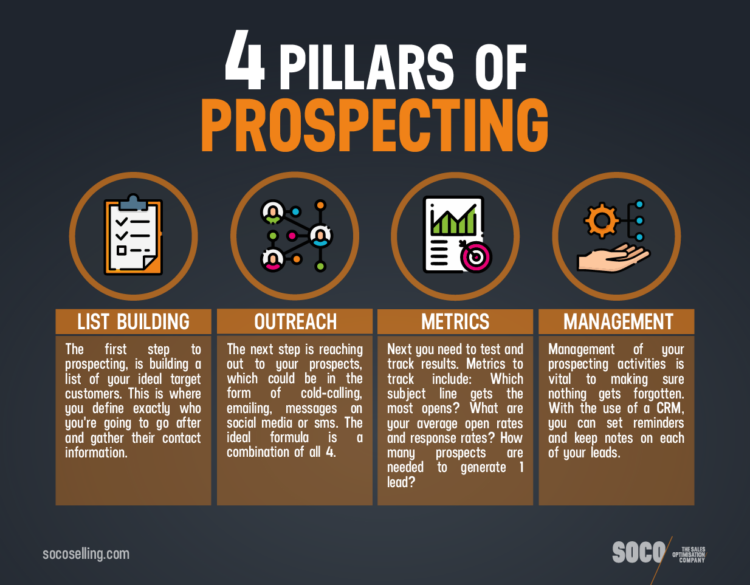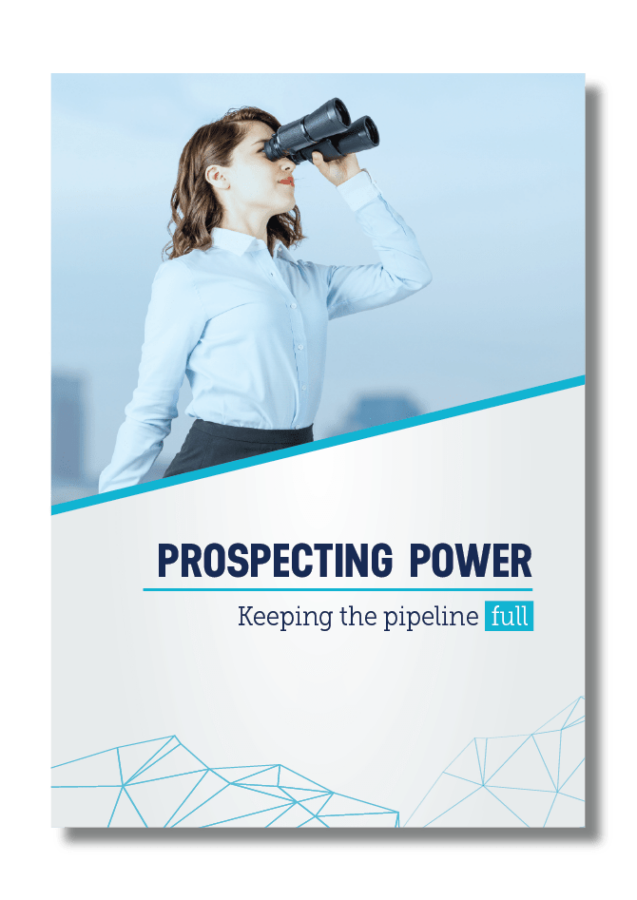
Lead generation is tricky. It’s time-consuming, laborious and sometimes pretty tedious. Many sales reps put it off until the last minute and end up with a dry pipeline, a cardinal sin in sales. But how can you close more deals without a full pipeline? You can’t, so stop waiting until you’re desperate for leads and wasting your time. Read on to discover a five-step sales prospecting plan that keeps your pipeline moving, alongside some best practices in prospecting.
What is a Sales Prospecting Plan?
A sales prospecting plan is a process that aids salespeople in finding potential customers to fill the sales pipeline. Without one, your prospecting success depends on sales reps to produce prospects.
The issue with this method is that they often yield prospects and leads that vary in quality. The result often leads to wasting time reps could have spent elsewhere.
Sales prospecting plans also focus on your sales team by creating a log of their actions and impacts – a tool that proves invaluable for accountability and progression.
Overall, a well-thought-out sales prospecting plan will help you to prospect quicker and better all within an efficient process that makes sense.
Also read:
- The Ultimate Guide To The Sales Prospecting Process (+ Email Templates)
- How To Get Prospects To Say YES
- Separating Suspects And Prospects: Improve The Leads In Your Funnel
4 Pillars of Every Effective Prospecting Plan
Before we delve into our 5-step sales prospecting plan that will keep your pipeline moving, let’s recap the four pillars that make up the prospecting process:

1. List Building
2. Outreach
3. Metrics
4. Management
When beginning to prospect, most sales reps’ first agenda is building a list of quality prospects. If you don’t, you run the real risk of losing time, energy, and money on prospects who are not likely to buy – and the wrong customers might be a drain on resources such as support.
How you choose to reach out to your prospects is your decision, regardless of whether you opt for traditional or modern prospecting and outreach methods – or both.
Metrics are numbers that tell you whether your prospecting activities are working.
Managing leads is time-consuming because you’re keeping track of multiple conversations, remembering how far along the sales cycle the prospect is and having to have all their relevant information at hand.
Why your Current Sales Prospecting Plan Isn’t Working
You’re here presumably because you feel like you’re doing everything right, yet you still aren’t getting a full pipeline of qualified leads.
When this happens, it can demoralize and leave you with more questions than answers.
Yet, instead of panicking at the end of the quarter and firing off random emails and LinkedIn messages, you should start to diagnose why your current sales prospecting plan isn’t working.
To help you figure out exactly why your current prospecting plan is failing you, here are some common reasons:
- You’re struggling to identify the prospect’s pain points.
- You’re spending prospecting time elsewhere, like manual data entry or other repetitive tasks you can automate.
- You lack the proper structure to make your cold-calling engaging and successful.
- You’re spending hours doing tired prospecting activities that generate little interest.
Ultimate 5-Step Strategic Sales Prospecting Plan
Ready to fuel the beast that is your sales pipeline? Start developing your prospecting process with our 5-step prospecting plan below:
1. Identify your Ideal Customer
Too many sales professionals waste time on sales prospects that don’t need their offering. Studies reveal that as many as 50% of prospects do not match your ideal buyer persona, so the first step is creating an ideal customer persona.
By researching customers who should care about your products, you can quickly identify whether the prospect in front of you is a good fit. Ask yourself if they fall into your target market. Are they willing to buy – and what is the means to buy it?
To help yourself determine your ideal customer persona, think about the following:
- Your top customers
- Your worst prospects
- Your most profitable customers
2. Set SMART Goals
Setting goals for your prospecting strategy can feel like an overwhelming task. But as Zig Ziglar said, “A goal properly set is halfway reached,” so you must ask yourself precisely what success looks like.
While most sales reps start with their sales targets and work backward, wherever you decide to start, you should make your prospecting goals SMART:
Specific
Specific prospecting goals have clear guidelines and a number and timeline.
Measurable
You can’t really determine your prospecting success without numbers. Therefore, it’s essential to use numerical data to assess progress later.
Attainable
While aiming for the stars is a great attitude, it’s not attainable. Your prospecting goals must require work to achieve – but not be completely out of reach.
Realistic
Similar to how they need to be attainable, they need to be realistic – otherwise, you risk ruining your morale through a lack of results.
Timely
Lastly, you need concrete deadlines for your goals – and stick to them! Doing this will increase your sales teams’ productivity and accountability when there’s a timeline attached to their activities.
3. Develop a Prospecting Pitch
While it’s true that sales reps should avoid jumping on Google, downloading one of many over-used sales scripts and using it verbatim – having a plan of what you’ll say helps. In a world where consumers don’t have the time or patience to work out what you’re trying to offer them – you need to know what you want to say – and how to say it.
To succeed in sales, more so prospecting, you must possess a repeatable and scalable formula. That’s where processes like our 60-second elevator sales pitch framework come in. Check it out below:

4. Create a Lead Qualification Checklist
When considering how to craft your approach, many make the mistake of hopping on Google and searching for a lead qualification script to use verbatim. This is wrong because you need to formulate your own hypothesis based on your specific market! Therefore, use these 3 As of qualifying to question your prospects and ensure you address their needs.
Ask
Does your prospect have a specific need? Are they genuinely interested or simply curious? When are they PLANNING (not simply thinking about) moving forward? What are they asking for and why? What will happen if they don’t do this? (consequence question).
Afford
Can they afford your solution? Do they have a budget? Have they undertaken something like this before? What did they invest in previously? Are they aware of the price RANGE? Does it seem reasonable to them?
Authority
Are you speaking with someone who has decision-making authority? Gatekeepers can say NO but can never say YES! Why waste time ‘selling’ to people who can’t say YES?! Ask the prospect questions like:
- Who needs to join our meeting?
- Who has a stake in the success of this project?
- Control the budget?
- Who is responsible for the outcome?
- Who has input that would be critical to share in this discussion?
5. Automate Repetitive Tasks
Many salespeople detest prospecting due to its time and energy-consuming nature, thanks to plenty of manual data handling, filing and organizing. But the rise of sales technology has made this issue defunct – if you know how to automate repetitive tasks, that is.
At the lowest level, a CRM should help sales reps reduce their time with these tasks – at the highest level, there are tons of options for artificial intelligence to run applications that take this a step further.
Best Practices in Sales Prospecting
Now you have the framework for your prospecting plan, ensure you keep your pipeline moving with these sales prospecting plan best practices:
Build your Personal Brand via LinkedIn
A LinkedIn personal brand reflects your story, values, and work and is an ongoing development process to maintain your reputation to an individual, group, or organization. When prospects search for your products, services or credentials online, your LinkedIn profile will be among the first three entries on the top of that search engine results page – sometimes, even the first one.
That’s why you need to view your LinkedIn profile as a free advertising space that you can use to build a relationship, tell your story, and add value to prospects. Turn your profile into a source for others to learn, get informed, laugh, and connect with you. Through that, you get their trust and eventually can talk about selling.
Encourage Client Referrals
An astounding 92% of people trust referrals from people they know – a golden opportunity for reps looking to fill their pipeline. If you can implement a client referral strategy into your sales prospecting plan, you’ll competitively be miles ahead of reps, still sticking to the trusted traditional prospecting strategies.
Use Videos for High Engagement
In today’s modern and mostly virtual selling landscape – 7 in 10 B2B buyers are watching videos during their buying process. Moreover, these buyers regularly watch 30+ minutes of video content when making these key decisions.
These statistics prove that video effectively communicates information to prospects, especially early in the buying process. You can target your ideal prospects by sharing engaging and valuable video content across your social media, through email campaigns or by sending them directly to prospects for a unique approach.
Allocate Prospecting Time
Whether you prefer to prospect in the morning, afternoon, or evening, you should always test times to see which is best for your ideal customer persona, then stick to it to hold yourself accountable for results.
Discover a New Way to Generate Leads
Like blood to a body, a full sales pipeline is necessary for your business to survive. The thing is, prospecting has evolved, and old methods just aren’t effective anymore.
Our Prospecting Power Training teaches participants how to ensure your customer acquisition strategy is creative, persistent, and, most importantly, generates real results.


